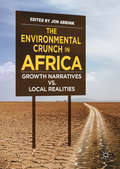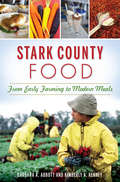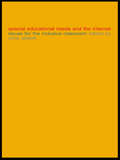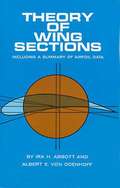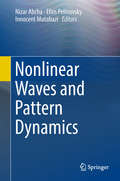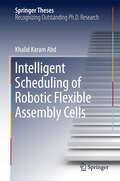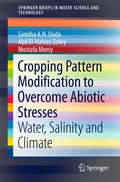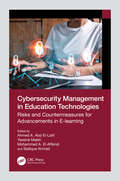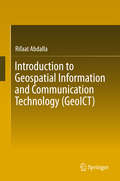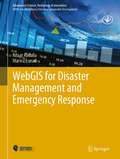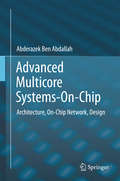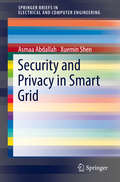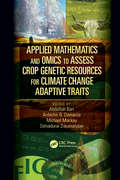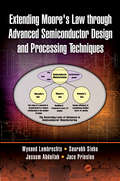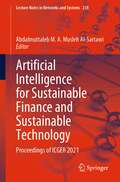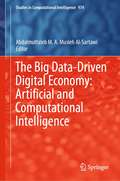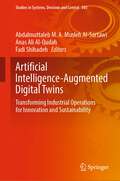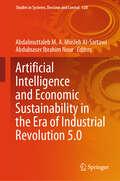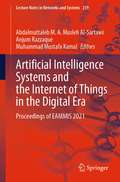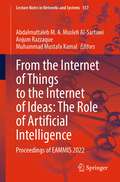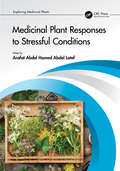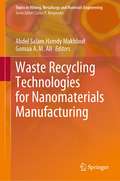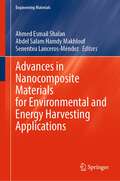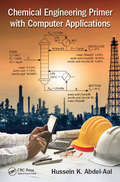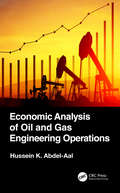- Table View
- List View
The Environmental Crunch in Africa: Growth Narratives Vs. Local Realities
by Jon AbbinkThis book discusses the problems and challenges of environmental–ecological conditions in Africa, amidst the current craze of economic growth and ‘development’. Africa’s significant economic dynamics and growth trajectories are marked by neglect of the environment, reinforcing ecological crises. Unless environmental–ecological and population growth problems are addressed as an integral part of developmental strategies and growth models, the crises will accelerate and lead to huge costs in later years. Chapters examine multiple emerging tension points all across the continent, including the potential benefits and harm of growing urban-based ecotourism, the trajectory of labour-saving technologies and the problems facing agro-pastoralism. Although environmental management and sustainability features of African rural societies should not be idealized, functional 'traditional' economies, interests and management practices are often bypassed, seen by state elites as inefficient and inhibiting 'growth'. In many regions the seeds are now sown for lasting environmental crises that will affect local societies that have rarely been given opportunity to claim accountability from the state regimes and donors driving these changes.
Stark County Food: From Early Farming to Modern Meals (American Palate)
by Barbara A. Abbott Kimberly A. KenneyWhether it's homemade chicken pot pie, a steak from Baker's Café or a frozen custard at Meyer's Lake, the food of Stark County has made mouths water for generations. The region's unique soil nurtured an early boom in agriculture, and growers like K.W. Zellers & Son Farms still make a living off the land today. Forgotten mom-and-pop grocery stores such as Flory's and Lemmon's served the needs of their neighborhoods, while long-gone restaurants like Mergus and Topp's Chalet created delicious dishes and cherished memories. Others, like Bender's Tavern and Taggart's Ice Cream Parlor, serve the same legendary fare they have for decades. Families such as the Millers and Swaldos have created nationally recognized destinations out of small and simple starts. Join authors Kim Kenney and Barb Abbott as they trace Stark County's food history from the earliest orchards and farms to today's culinary tourism scene.
Special Educational Needs and the Internet: Issues for the Inclusive Classroom
by Chris AbbottWith Internet access for every school now a reality, teachers are beginning to explore the use of the Internet in the education of children with special needs. This book describes its benefits for children across the spectrum of special educational needs, from those with physical disabilities or sensory impairment to those with learning or social difficulties.With contributions from leading practitioners in the field, this book addresses the huge range of possibilities the Internet and associated technology offer for these pupils. Combining current theory and debate with practical guidance and inspiring case studies, this book considers:* how the Internet can be used to gather and publish information* how to communicate effectively through technology* policy and management issues for schools* the continuing challenges for access and inclusion.This book will be of interest to all teachers involved in special education needs, in both mainstream and special schools.
Theory of Wing Sections: Including a Summary of Airfoil Data
by Ira H. Abbott A. E. Doenhoff"Most useful in working with wing sections and methods for using section data to predict wing characteristics . . . much detailed geometric and aerodynamic data." -- Mechanical EngineeringThe first edition of this work has been corrected and republished in answer to the continuing demand for a concise compilation of the subsonic aerodynamics characteristics of modern NASA wing sections together with a description of their geometry and associated theory. These wing sections, or their derivatives, continue to be the ones most commonly used for airplanes designed for both subsonic and supersonic speeds, and for helicopter rotor blades, propeller blades, and high performance fans.Intended to be primarily a reference work for engineers and students, the book devotes over 300 pages to theoretical and experimental considerations. The theoretical treatment progresses from elementary considerations to methods used for the design of NACA low-drag airfoils. Methods and data are presented for using wingsection data to predict wing characteristics, and judiciously selected plots and cross-plots of experimental data are presented for readily useful correlation of certain simplifying assumptions made in the analyses. The chapters on theory of thin wings and airfoils are particularly valuable, as is the complete summary of the NACA's experimental observations and system of constructing families of airfoils. Mathematics has been kept to a minimum, but it is assumed that the reader has a knowledge of differential and integral calculus, and elementary mechanics.The appendix of over 350 pages contains these tables: Basic Thickness Forms, Mean Lines, Airfoil Ordinates, and Aerodynamic Characteristics of Wing Sections.
Nonlinear Waves and Pattern Dynamics
by Nizar Abcha Efim Pelinovsky Innocent MutabaziThis book addresses the fascinating phenomena associated with nonlinear waves and spatio-temporal patterns. These appear almost everywhere in nature from sand bed forms to brain patterns, and yet their understanding still presents fundamental scientific challenges. The reader will learn here, in particular, about the current state-of-the art and new results in: Nonlinear water waves: resonance, solitons, focusing, Bose-Einstein condensation, as well as and their relevance for the sea environment (sea-wind interaction, sand bed forms, fiber clustering) Pattern formation in non-equilibrium media: soap films, chimera patterns in oscillating media, viscoelastic Couette-Taylor flow, flow in the wake behind a heated cylinder, other pattern formation. The editors and authors dedicate this book to the memory of Alexander Ezersky, Professor of Fluid Mechanics at the University of Caen Normandie (France) from September 2007 to July 2016. Before 2007, he had served as a Senior Scientist at the Institute of Applied Physics of the Russian Academy of Sciences in Nizhny Novgorod (Russia). The chapters have been written by leading scientists in Nonlinear Physics, and the topics chosen so as to cover all the fields to which Prof. Ezersky himself contributed, by means of experimental, theoretical and numerical approaches. The volume will appeal to advanced students and researchers studying nonlinear waves and pattern dynamics, as well as other scientists interested in their applications in various natural media.
Intelligent Scheduling of Robotic Flexible Assembly Cells
by Dr Khalid Karam AbdThis book focuses on the design of Robotic Flexible Assembly Cell (RFAC) with multi-robots. Its main contribution consists of a new effective strategy for scheduling RFAC in a multi-product assembly environment, in which dynamic status and multi-objective optimization problems occur. The developed strategy, which is based on a combination of advanced solution approaches such as simulation, fuzzy logic, system modeling and the Taguchi optimization method, fills an important knowledge gap in the current literature and paves the way for future research towards the goal of employing flexible assembly systems as effectively as possible despite the complexity of their scheduling.
Cropping Pattern Modification to Overcome Abiotic Stresses: Water, Salinity and Climate (SpringerBriefs in Water Science and Technology)
by Abd El-Hafeez Zohry Samiha A. H. Ouda Mostafa MorsyThis book provides state-of-the art analysis, never done before in Egypt, on agro-climatic zones level. This study deals with how the national cropping pattern can be modified to overcome abiotic stresses, such as water scarcity, induced salinity and climate change to reduce their negative effects on food production. To this end, different cropping patterns are suggested. This study can be a framework for other developing countries to be used in quantifying and filling the gap in their knowledge about practices that can help in increasing their food security through increasing food production. Furthermore, the study is useful for policy makers to help them in their future plans and policies.
Cybersecurity Management in Education Technologies: Risks and Countermeasures for Advancements in E-learning
by Abd El-Latif, Ahmed A.This book explores the intersection of cybersecurity and education technologies, providing practical solutions, detection techniques, and mitigation strategies to ensure a secure and protected learning environment in the face of evolving cyber threats. With a wide range of contributors covering topics from immersive learning to phishing detection, this book is a valuable resource for professionals, researchers, educators, students, and policymakers interested in the future of cybersecurity in education. Features: • Offers both theoretical foundations and practical guidance for fostering a secure and protected environment for educational advancements in the digital age. • Addresses the need for cybersecurity in education in the context of worldwide changes in education sources and advancements in technology. • Highlights the significance of integrating cybersecurity into educational practices and protecting sensitive information to ensure students’ performance prediction systems are not misused. • Covers a wide range of topics including immersive learning, cybersecurity education, and malware detection, making it a valuable resource for professionals, researchers, educators, students, and policymakers.
Introduction to Geospatial Information and Communication Technology (GeoICT)
by Rifaat AbdallaThis book is designed to help students and researchers understand the latest research and development trends in the domain of geospatial information and communication (GeoICT) technologies. Accordingly, it covers the fundamentals of geospatial information systems, spatial positioning technologies, and networking and mobile communications, with a focus on OGC and OGC standards, Internet GIS, and location-based services. Particular emphasis is placed on introducing GeoICT as an integrated technology that effectively bridges various information-technology domains.
WebGIS for Disaster Management and Emergency Response (Advances in Science, Technology & Innovation)
by Rifaat Abdalla Marwa EsmailThis book aims to help students, researchers and policy makers understand the latest research and development trends in the application of WebGIS for Disaster Management and Emergency Response. It is designed as a useful tool to better assess the mechanisms for planning, response and mitigation of the impact of disaster scenarios at the local, regional or national levels. It contains details on how to use WebGIS to solve real-world problems associated with Disaster Management Scenarios for the long-term sustainability. The book broadens the reader understanding of the policy and decision-making issues related to Disaster Management response and planning.
Advanced Multicore Systems-On-Chip: Architecture, On-Chip Network, Design
by Abderazek Ben AbdallahFrom basic architecture, interconnection, and parallelization to power optimization, this book provides a comprehensive description of emerging multicore systems-on-chip (MCSoCs) hardware and software design. Highlighting both fundamentals and advanced software and hardware design, it can serve as a primary textbook for advanced courses in MCSoCs design and embedded systems. The first three chapters introduce MCSoCs architectures, present design challenges and conventional design methods, and describe in detail the main building blocks of MCSoCs. Chapters 4, 5, and 6 discuss fundamental and advanced on-chip interconnection network technologies for multi and many core SoCs, enabling readers to understand the microarchitectures for on-chip routers and network interfaces that are essential in the context of latency, area, and power constraints. With the rise of multicore and many-core systems, concurrency is becoming a major issue in the daily life of a programmer. Thus, compiler and software development tools are critical in helping programmers create high-performance software. Programmers should make sure that their parallelized program codes will not cause race condition, memory-access deadlocks, or other faults that may crash their entire systems. As such, Chapter 7 describes a novel parallelizing compiler design for high-performance computing. Chapter 8 provides a detailed investigation of power reduction techniques for MCSoCs at component and network levels. It discusses energy conservation in general hardware design, and also in embedded multicore system components, such as CPUs, disks, displays and memories. Lastly, Chapter 9 presents a real embedded MCSoCs system design targeted for health monitoring in the elderly.
Security and Privacy in Smart Grid (SpringerBriefs in Electrical and Computer Engineering)
by Asmaa Abdallah Xuemin ShenThis SpringerBrief addresses the main security concerns for smart grid, e.g., the privacy of electricity consumers, the exchanged messages integrity and confidentiality, the authenticity of participated parties, and the false data injection attacks. Moreover, the authors demonstrate in detail the various proposed techniques to secure the smart grid’s different communication networks and preserve the privacy of the involved. Over many years, power grid has generated electricity from central generators and distributed it in one direction from the generation stations to end-users; also, information is one directional so that the grid’s control center doesn’t get enough information about customers’ requirements and consequently can’t prevent electricity losses. So, the electricity grid is merged with information and communication technology to form smart grid. The main target of this incorporation is to connect different parties of power grid to exchange information about grid conditions and customers’ requirements, and consequently, improve the reliability and efficiency of electricity generation and distribution. That upgrade of the power grid exposes it to the cyber security threats that the communication networks suffer from, such as malicious attacks to forge the electricity consumption readings or price, extract personal information for residential consumers, such as daily habits and life style, or attack some grid’s resources and equipment availability using denial-of-service attacks. Also, novel threats are introduced in smart grid due to the power grid nature, such as false data injection attack, in which the adversary compromises several measurement units and injects false information about the grid conditions that mislead the grid’s control center to make wrong decisions for the grid and consequently impact on its stability and efficiency.
Applied Mathematics and Omics to Assess Crop Genetic Resources for Climate Change Adaptive Traits
by Abdallah Bari, Ardeshir B. Damania, Michael Mackay and Selvadurai DayanandanApplied Mathematics and Omics to Assess Crop Genetic Resources for Climate Change Adaptive Traits focuses on practical means and approaches to further the use of genetic resources for mitigating the effects of climate change and improving crop production. Genetic diversity in crop plants is being further explored to increase yield, disease resistance, and nutritional value by employing recent advances in mathematics and omics technologies to promote the adaptation of crops to changing climatic conditions. This book presents a broad view of biodiversity and genetic resources in agriculture and provides answers to some current problems. It also highlights ways to provide much-needed information to practitioners and innovators engaged in addressing the effects of global climate change on agriculture. The book is divided into sections that cover: The implications of climate change for drylands and farming communities The potential of genetic resources and biodiversity to adapt to and mitigate climate change effects Applications of mathematics and omics technologies Genomics and gene identification We are in the midst of significant changes in global climates, and its effects are already being felt throughout the world. The increasing frequency of droughts and heat waves has had negative impacts on agricultural production, especially in the drylands of the world. This book shares the collective knowledge of leading scientists and practitioners, giving readers a broader appreciation and heightened awareness of the stakes involved in improving and sustaining agricultural production systems in the face of climate change.
Extending Moore's Law through Advanced Semiconductor Design and Processing Techniques
by Jassem Abdallah Wynand Lambrechts Saurabh Sinha Jaco PrinslooThis book provides a methodological understanding of the theoretical and technical limitations to the longevity of Moore’s law. The book presents research on factors that have significant impact on the future of Moore’s law and those factors believed to sustain the trend of the last five decades. Research findings show that boundaries of Moore’s law primarily include physical restrictions of scaling electronic components to levels beyond that of ordinary manufacturing principles and approaching the bounds of physics. The research presented in this book provides essential background and knowledge to grasp the following principles: Traditional and modern photolithography, the primary limiting factor of Moore’s law Innovations in semiconductor manufacturing that makes current generation CMOS processing possible Multi-disciplinary technologies that could drive Moore's law forward significantly Design principles for microelectronic circuits and components that take advantage of technology miniaturization The semiconductor industry economic market trends and technical driving factors The complexity and cost associated with technology scaling have compelled researchers in the disciplines of engineering and physics to optimize previous generation nodes to improve system-on-chip performance. This is especially relevant to participate in the increased attractiveness of the Internet of Things (IoT). This book additionally provides scholarly and practical examples of principles in microelectronic circuit design and layout to mitigate technology limits of previous generation nodes. Readers are encouraged to intellectually apply the knowledge derived from this book to further research and innovation in prolonging Moore’s law and associated principles.
Artificial Intelligence for Sustainable Finance and Sustainable Technology: Proceedings of ICGER 2021 (Lecture Notes in Networks and Systems #423)
by Abdalmuttaleb M. A. Musleh Al-SartawiThis book shows latest research on artificial intelligence for sustainable technology. ICGER 2021 was organized by the Accounting, Finance and Banking Department at Ahlia University, Bahrain, and was conducted on the 15th and 16th of September. The strategic partners included the University of Jordan, the Bahrain Economists Society, the Association of Chartered Certified Accountants: ACCA, Al-Barka Banking Group and the International Computer Auditing Education Association: ICAEA . The theme of the ICGER 2021 centered around artificial intelligence for sustainable finance and sustainable technology. Accordingly, the papers presented at the conference provided a holistic view of sustainable finance, sustainability, AI, financial technology, cybersecurity, blockchain, CSR, and governance. This book, unlike ever before, brings together intelligence applications of new technologies and the sustainability requirements in the era of the digital economy, with special attention given to the opportunities, challenges, for education, business growth, and economic progression of nations which will help societies (economists, financial managers, engineers, ICT specialists, digital managers, data managers, policymakers, regulators, researchers, academics, and students) to better understand, use, and control AI applications and financial technologies to develop future strategies and to achieve sustainable development goals.
The Big Data-Driven Digital Economy: Artificial and Computational Intelligence (Studies in Computational Intelligence #974)
by Abdalmuttaleb M. A. Musleh Al-SartawiThis book shows digital economy has become one of the most sought out solutions to sustainable development and economic growth of nations. This book discusses the implications of both artificial intelligence and computational intelligence in the digital economy providing a holistic view on AI education, economics, finance, sustainability, ethics, governance, cybersecurity, blockchain, and knowledge management. Unlike other books, this book brings together two important areas, intelligence systems and big data in the digital economy, with special attention given to the opportunities, challenges, for education, business growth, and economic progression of nations. The chapters hereby focus on how societies can take advantage and manage data, as well as the limitations they face due to the complexity of resources in the form of digital data and the intelligence which will support economists, financial managers, engineers, ICT specialists, digital managers, data managers, policymakers, regulators, researchers, academics, students, economic development strategies, and the efforts made by the UN towards achieving their sustainability goals.
Artificial Intelligence-Augmented Digital Twins: Transforming Industrial Operations for Innovation and Sustainability (Studies in Systems, Decision and Control #503)
by Abdalmuttaleb M. A. Musleh Al-Sartawi Anas Ali Al-Qudah Fadi ShihadehPresently, we stand on the threshold of a technological revolution that will drastically change the way we live, work, and communicate with each other. By the current rate, scope, and complexity, this transformation will be as fundamental for society as any other technological paradigm change from the past. The industries which are more susceptible to change are technologically oriented industries including banking, finance, accounting, and auditing. One of the technological concepts of the technological revolution is the concept of the digital twin.The application of digital twins and AI as paired with Internet of Things technologies makes it possible to solve ESG problems on a completely different level (Li, 2019) for accounting firms and financial institutions. These include recycling on demand, rational energy consumption, smart surveillance cameras for crime tracking, and smart branch parking solutions, monitoring the wear and tear and conditions of financial technology infrastructures.Moreover, numerous researchers and practitioners emphasize the significance of innovating sustainable business models and operations (Geissdoerfer et al., 2018). The digital twin will allow businesses and financial institutions to minimize costs, boost customer service, and find new ways to generate revenue. DTW is accessible now more than ever, and many reputable and innovative companies such as Tesla, Ericsson, and Siemens have adopted it with varying success.Therefore, this book examines the opportunities, challenges, and risks of artificial intelligence-augmented digital twins for financial operations, innovation, and sustainable development. It focuses on AI and digital twin technologies to furnish solutions for the current industrial revolution including the Metaverse. Henceforth, this book aims to encourage authors to submit multi-disciplinary chapters indicating the current scholarly challenges about the applications and potential of artificial intelligence and digital twins in accounting, finance, and banking.
Artificial Intelligence and Economic Sustainability in the Era of Industrial Revolution 5.0 (Studies in Systems, Decision and Control #528)
by Abdalmuttaleb M. A. Musleh Al-Sartawi Abdulnaser Ibrahim NourIndustry 5.0 has been dubbed as the digital revolution with a soul. This book incorporates a wealth of research which integrates artificial intelligence (AI) with economic sustainability and Industry 5.0. It examines the human-centricity of the upcoming digital revolution and the role of sustainable technologies in enhancing the livelihoods of workers, individuals, communities, and eventually societies. It provides insight on important areas related to artificial intelligence, sustainable development, and society 5.0. The chapters present a wide range of topics including block cipher, entrepreneurship and AI, AI and stock trading decisions, digital transformation, knowledge management, chatbot engineering, cybersecurity, and smart metering system. This book is beneficial to scholars and academics who will find in it the knowledge of the support of AI and its contribution to economic sustainability, and solutions to enhance human-centricity and resilience.
Artificial Intelligence Systems and the Internet of Things in the Digital Era: Proceedings of EAMMIS 2021 (Lecture Notes in Networks and Systems #239)
by Abdalmuttaleb M. A. Musleh Al-Sartawi Anjum Razzaque Muhammad Mustafa KamalThis book brings together intelligence systems and the Internet of Things, with special attention given to the opportunities, challenges, for education, business growth, and economic progression of nations which will help societies (economists, financial managers, engineers, ICT specialists, digital managers, data managers, policymakers, regulators, researchers, academics, and students) to better understand, use, and control AI and IoT to develop future strategies and to achieve sustainability goals. EAMMIS 2021 was organized by the Bridges Foundation in cooperation with the Istanbul Medeniyet University, Istanbul, Turkey, on March 19–20, 2021. EAMMIS 2021 theme was Artificial Intelligence Systems and the Internet of Things in the digital era. The papers presented at the conference provide a holistic view of AI education, MIS, cybersecurity, blockchain, Internet of Ideas (IoI), and knowledge management.
From the Internet of Things to the Internet of Ideas: Proceedings of EAMMIS 2022 (Lecture Notes in Networks and Systems #557)
by Abdalmuttaleb M. A. Musleh Al-Sartawi Anjum Razzaque Muhammad Mustafa KamalThis book shows latest research on the role Artificial inelegance in enabling IoT to evoke IoI, and how IoI flourish inside technologies like social media platforms, social networks: communities of practice/interest, to assure a globally sustainable unit where humans integrate with machines to collaboratively share ideas and solve complex problems. Such a book holds several benefits. It will reveal theoretical practical, and managerial implications through discussions that will embrace a wide array of technologies focused on the role of AI enabled IoT to evoke IoI. EAMMIS 2022 was organized by the Bridges Foundation in cooperation with Coventry University, UK on the 10th and 11th of June 2022. EAMMIS 2022 theme was From the Internet of Things to the Internet of Ideas: The role of Artificial Intelligence. The papers presented at the conference provide a holistic view of AI and its applications, IOT and the IOI which will help societies to better use and benefit from AI, IOT and IOI to develop future strategies and actions.
Medicinal Plant Responses to Stressful Conditions (Exploring Medicinal Plants)
by Abdel Latef, Arafat Abdel HamedMedicinal Plant Responses to Stressful Conditions discusses the effects of multiple biotic and abiotic stressors on medicinal plants. It features information on biochemical, molecular and physiological strategies used to mitigate or alleviate detrimental effects of biotic and abiotic stressors. The book contains chapters featuring medicinal plants of importance covering subjects including genomics, functional genomics, metabolomics, phenomics, proteomics and transcriptomics under biotic and abiotic stress of medicinal plants and their molecular responses. It suggests exogenous application of different types of stimulants to enhance medicinal plant production in such conditions. Features: Details all aspects of biotic and abiotic stressors in various important medicinal plant species. Chapters cover evidence-based approaches in the diagnosis and management of medicinal plants under stressful conditions. Includes information on ways to mitigate effects from biotic stress (diseases and pests) or abiotic stress (high salinity, drought, temperature extremes, waterlogging, wind, high light intensity, UV radiation, heavy metals and mineral deficiencies). A volume in the Exploring Medicinal Plants series, this book is an essential resource for plant scientists, botanists, environmental scientists and anyone with an interest in herbal medicine.
Waste Recycling Technologies for Nanomaterials Manufacturing (Topics in Mining, Metallurgy and Materials Engineering)
by Abdel Salam Hamdy Makhlouf Gomaa A. M. AliThis book discusses the recent advances in the wastes recycling technologies to provide low-cost and alternative ways for nanomaterials production. It shows how carbon nanomaterials can be synthesized from different waste sources such as banana fibers, argan (Argania spinosa) seed shells, corn grains, camellia oleifera shell, sugar cane bagasse, oil palm (empty fruit bunches and leaves) and palm kernel shells. Several nanostructured metal oxides (MnO2, Co3O4,….) can be synthesized via recycling of spent batteries. The recovered nanomaterials can be applied in many applications including: Energy (supercapacitors, solar cells, etc.) water treatments (heavy metal ions and dyes removal) and other applications. Spent battery and agriculture waste are rich precursors for metals and carbon, respectively. The book also explores the various recycling techniques, agriculture waste recycling, batteries recycling, and different applications of the recycled materials.
Advances in Nanocomposite Materials for Environmental and Energy Harvesting Applications (Engineering Materials)
by Abdel Salam Hamdy Makhlouf Senentxu Lanceros‐Méndez Ahmed Esmail ShalanThis book discusses the fundamental, synthesis, properties, physico-chemical characterizations and applications of recently explored nanocomposite materials. It covers the applications of these different nanocomposite materials in the environmental and energy harvesting fields. The chapters explore the different techniques used for preparation and characterization of several types of nanocomposite materials for applications related to environmental and energy pathways. This book presents a panorama of current research in the field of nanocomposite structures for different applications. It also assesses the advantages and disadvantages of using different types of nanocomposite in the design of different material products. The comprehensive chapters explain the interactions between nanocomposite materials and mechanisms related to applications in environmental pollution and energy shortage.
Chemical Engineering Primer with Computer Applications
by Hussein K. Abdel-AalTaking a highly pragmatic approach to presenting the principles and applications of chemical engineering, this companion text for students and working professionals offers an easily accessible guide to solving problems using computers. The primer covers the core concepts of chemical engineering, from conservation laws all the way up to chemical kinetics, without heavy stress on theory and is designed to accompany traditional larger core texts. The book presents the basic principles and techniques of chemical engineering processes and helps readers identify typical problems and how to solve them. Focus is on the use of systematic algorithms that employ numerical methods to solve different chemical engineering problems by describing and transforming the information. Problems are assigned for each chapter, ranging from simple to difficult, allowing readers to gradually build their skills and tackle a broad range of problems. MATLAB and Excel® are used to solve many examples and the more than 70 real examples throughout the book include computer or hand solutions, or in many cases both. The book also includes a variety of case studies to illustrate the concepts and a downloadable file containing fully worked solutions to the book’s problems on the publisher’s website. Introduces the reader to chemical engineering computation without the distractions caused by the contents found in many texts. Provides the principles underlying all of the major processes a chemical engineer may encounter as well as offers insight into their analysis, which is essential for design calculations. Shows how to solve chemical engineering problems using computers that require numerical methods using standard algorithms, such as MATLAB® and Excel®. Contains selective solved examples of many problems within the chemical process industry to demonstrate how to solve them using the techniques presented in the text. Includes a variety of case studies to illustrate the concepts and a downloadable file containing fully worked solutions to problems on the publisher’s website. Offers non-chemical engineers who are expected to work with chemical engineers on projects, scale-ups and process evaluations a solid understanding of basic concepts of chemical engineering analysis, design, and calculations.
Economic Analysis of Oil and Gas Engineering Operations
by Hussein K. Abdel-AalEngineers seek solutions to problems, and the economic viability of each potential solution is normally considered along with the technical merits. This is typically true for the petroleum sector, which includes the global processes of exploration, production, refining, and transportation. Decisions on an investment in any oil or gas field development are made on the basis of its value, which is judged by a combination of a number of economic indicators. Economic Analysis of Oil and Gas Engineering Operations focuses on economic treatment of petroleum engineering operations and serves as a helpful resource for making practical and profitable decisions in oil and gas field development. Reflects major changes over the past decade or so in the oil and gas industry Provides thorough coverage of the use of economic analysis techniques in decision-making in petroleum-related projects Features real-world cases and applications of economic analysis of various engineering problems encountered in petroleum operations Includes principles applicable to other engineering disciplines This work will be of value to practicing engineers and industry professionals, managers, and executives working in the petroleum industry who have the responsibility of planning and decision-making, as well as advanced students in petroleum and chemical engineering studying engineering economics, petroleum economics and policy, project evaluation, and plant design.
